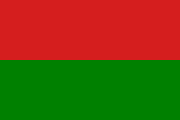Popular Socialists (Russia)
Labourist Popular-Socialist Party Трудовая народно-социалистическая партия | |
|---|---|
Democratic Socialism Reformism | |
| Political position | Centre-left |
| Party flag | |
 | |
The Popular Socialist Party (Russian: Трудовая народно-социалистическая партия, romanized: Trudovaya Narodno-Sotsialisticheskaya Partiya, lit. 'Labourist Popular-Socialist Party') emerged in Russia in the early twentieth century.
History
The roots of the Popular Socialist Party (NSP) lay in the 'Legal Populist' movement of the 1890s, and its founders looked upon
The Popular Socialists also wanted to indemnify landowners; the PSR did not. Furthermore, the Popular Socialists deplored the influence of
The Popular Socialists collaborated closely with the Trudoviks (Labour Group), Kerensky's party in the State Duma. After the February Revolution of 1917, the Popular Socialist Party merged with the Trudoviks and actively supported the Provisional Government, in which it was represented.
The Popular Socialists opposed the October Revolution. The party was dissolved during the Russian Civil War of 1918–1922.
The party's Russian name is sometimes translated as 'National Socialist Party', but this is misleading, since that label is usually associated with Hitler's National Socialist German Workers' Party (NSDAP). The Russian NSP was not anti-Semitic and advocated democracy and gradual reform.
Further reading
- Hildermeier, M., Die Sozialrevolutionäre Partei Russlands. Cologne, 1978.
- The Great Soviet Encyclopedia. Moscow, 1978.
